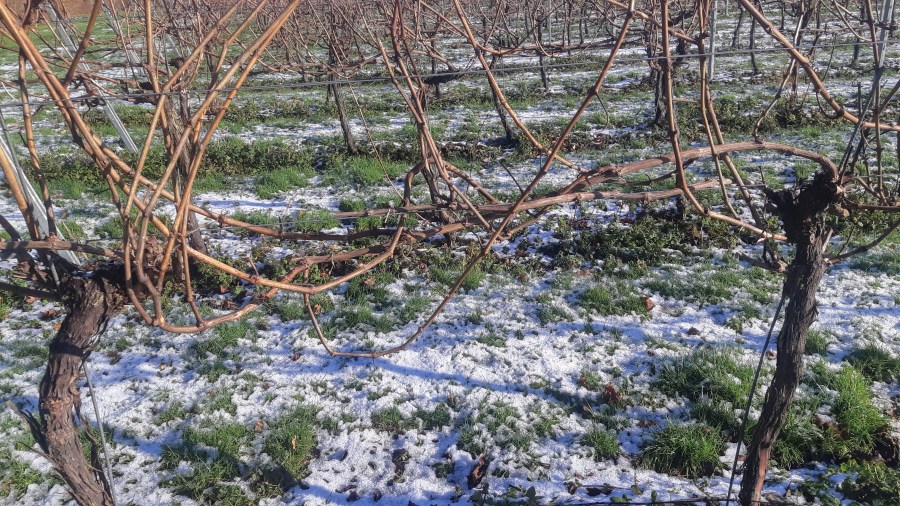The end of harvest marks the transition into late autumn and winter, giving vineyard managers time to lay the groundwork for the year ahead.
This year’s excellent weather meant harvest came early. This gives vines more time post-harvest to accumulate carbohydrates before winter sets in. By continuing to photosynthesise, they build starch reserves in their perennial structures (roots and trunks) before dormancy. These reserves are vital for winter survival and fueling spring growth; insufficient stores can lead to lower yields and weak vegetative development. Post-harvest foliar nutrition and protective sprays can help boost this process and keep mildews at bay.
Pre-Christmas tasks
Before frost sets in, it is essential to carry out routine maintenance to protect vineyard infrastructure and prepare for the months ahead:
- Empty wavter storage and winterise pipes: Drain IBCs (intermediate bulk containers) to prevent algae growth and frost damage. Turn off water supplies and insulate pipes against freezing.
- Sprayer maintenance: Detach main pipes, run an antifreeze-water solution through pumps and nozzles, and book any MOTs before next season.
- Weather sensors: Refill wet bulb reservoirs to maintain accurate data through winter.
- Equipment and machinery: Inspect and repair all machinery and tools, taking note of parts that need replacement before pruning season.
- Stock up on supplies: Order pruning tools, ties, and wire early to ensure operations can begin smoothly in the new year.
Pests and disease
Although pest activity decreases in winter, end-of-season sprays before leaf fall help reduce overwintering diseases on vine wood. These should be applied soon after harvest while ground conditions remain favourable.
Equipment and trellising
Winter is the ideal time for servicing and repairs. Beyond tractors and sprayers, hand tools like secateurs and saws, must be cleaned and sharpened ahead of pruning.
General vineyard maintenance is equally critical. Trellis systems should be inspected for damage, with broken posts replaced, wires tightened, and end assemblies repaired. Strong trellises are essential to support canopy weight and fruit, and to ensure tractor operations run smoothly. Drainage ditches should be cleared, hedgerows tidied, and overhanging trees trimmed before spring.
With mechanisation becoming central to vineyard management, trellis design and strength are more important than ever.
- Use 1.5mm hot-dipped galvanised posts for intermediates and 2.5mm for end posts.
- Replace damaged posts while vines are bare.
- Ensure intermediates are installed at uniform height (2.5m, with 0.7m buried for stability).
- Keep wires taut with tools such as Gripple Tensioners.
Soil sampling
Winter is also the right moment for soil sampling. Collect representative samples by block or variety and send them for broad-spectrum analysis covering both macronutrients and micronutrients. Results can be interpreted by your agronomist, allowing fertiliser orders to be placed in advance, ready for spring application windows.
Frost protection
Conventional frost protection (candles, fans, sprinklers, or burners) should be checked and serviced during winter, with teams trained in their correct use. Winter also provides time to investigate newer systems, such as infrared-based solutions like Frolight Frost Protection. Pruning techniques, like double pruning and sacrificial canes, can be used to support frost management.
Plan for next year
Finally, winter offers managers time to step back and reflect. Review records from the season (e.g., yields, pest pressures, weather patterns, and interventions) and use them to guide decisions on planting, replacing old vines, or adjusting pruning to balance crop load. Canopy management systems should also be reassessed. Preparing budgets and schedules now ensures a smoother transition into spring.
Final thoughts
Winter is not just a time of rest for the vines but a crucial season of preparation. From frost-proofing infrastructure and servicing equipment to reinforcing trellises and planning for the year ahead, this period ensures the vineyard is ready for the demands of spring and summer. By investing in these winter tasks, vineyard managers set the stage for healthier vines, stronger canopies, and more reliable yields.




